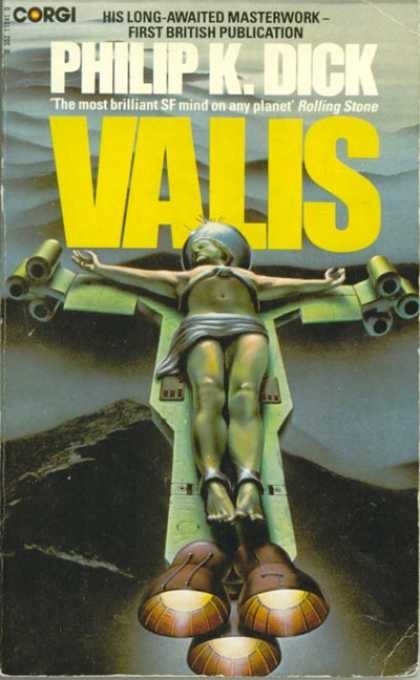Philip K. Dick
by Gabriel Mckee
“I am a fictionalizing philosopher, not a novelist,” Philip K. Dick wrote in 1981. “My novel & story-writing ability is employed as a means to formulate my perception. The core of my writing is not art but truth.” These words, written a few months before his death in 1982, sum up a quarter-century of writing about the shaky foundations of the universe—foundations which were eventually undermined, not only in his fiction, but in his life.
“Roog” (1953) was Dick’s first professional sale. It is a story told from the point of view of a dog barking at a garbage truck, because he sees—correctly, as his complacent human owners do not—that the garbage men are aliens preparing for an invasion. The early novel Eye in the Sky is a tour through the private kosmoi of a group of everyday people caught in a bizarre accident in a science lab. Their individual neuroses—from anti-communist paranoia to religious conservatism to neo-Victorian prudishness—produce a parade of universes that is at turns both hilarious and nightmarish. By the late ‘60s, the philosophical groundwork of his novels was becoming more sophisticated. In Do Androids Dream of Electric Sheep? Dick explored a sophisticated ethical system, contrasting the detached emotional flatness of the android (and its human counterpart, the sociopath) with the authentic, definitive quality of humanity: compassion. The Three Stigmata of Palmer Eldritch is a parable of evil told through the lens of psychedelic substances and the doctrine of transubstantiation. Most of Ubik takes place in a hallucinatory “half-life” universe that is gradually deteriorating, succumbing to the forces of entropy.
Dick’s stories serve to undermine the readers’ faith in ontology—he is poking the universe with a pin to see if it pops.
And, in 1974, it did—for Dick himself, at least. In February, he had surgery to remove two impacted wisdom teeth. A few days later, in intense pain, he called the pharmacy to have some pain medication delivered. When it arrived, he noticed that the delivery girl was wearing a necklace in the shape of a fish. (Tessa Dick, his wife at the time, theorizes he was using the necklace as an excuse to look down her blouse.) Touching the necklace, the girl explained that it was a symbol used by the early Christians. At this moment, Dick explains, he was hit by a sudden epiphany, almost like a recovered memory. Over the course of the next several months, Dick had a variety of strange experiences. He saw the buildings around him replaced with Roman architecture. He had a vision of abstract graphics, like expressionist paintings, that lasted an entire night. He had dreams in which he heard snatches of ancient languages—Greek and Sanskrit—and was shown enormous books that contained mysterious truths. He felt as if he were being taken over, invaded by another personality—a benevolent one, that wished to fix what was broken, both in his own life and in the universe as a whole.
Dick developed many theories about the identity of this personality: it may have been an early Christian from the period of the book of Acts; it may have been his late friend, the excommunicated Episcopalian Bishop James Pike; it may have been the Philip K. Dick of a parallel universe; it may have been the Holy Spirit itself.
Dick’s experiences in 1974 (which he later referred to as “2-3-74,” referring to their commencement in February and March 1974) formed the basis for his final novels, most notably VALIS. This novel offers a fictionally-skewed account of those experiences, with Dick himself split into two characters: the relatively logical and skeptical Phil Dick and the eccentric mystic Horselover Fat. But the lion’s share of Dick’s post-1974 writing was not fiction at all: for the final eight years of his life, Dick wrote over 8,000 pages of notes on his experiences, mostly by hand, in what he came to call The Exegesis. In this philosophical journal, Dick proposed, explored, and tested one theory after another to explain what had happened to him, from the grand (the return of the Holy Spirit) to the paranoid (Soviet scientists experimenting with telepathy and time manipulation) to the soberly mundane (maybe it was just psychosis, after all). It’s difficult, if not impossible, to categorize these theories—this one metaphysical, this mystical, that political—because these categories overlap and coexist. The theories feed one another, growing and expanding exponentially.
Though no theory proved permanent, the Exegesis’ recurring themes show Dick to be deeply concerned with oppression and liberation, both spiritual and literal. Throughout the journal he proposes the notion of an ancient, secret, revolutionary Christian underground, pitted against the Roman Empire, symbolized as the Black Iron Prison—a metaphysical category encompassing every form of repression, imprisonment, and tyranny. This concept of a radical, secret church puts Dick within arm’s reach of Christian anarchist ideas, akin to the early Quakers and their fellow travelers. (Dick himself claimed to have been raised Quaker, though the evidence supporting this is spotty).
Though our political and economic systems put the strong before the weak, coasting along with the status quo still seems the logical thing to do. And it’s not just our human institutions that are unjust: Dick finds fault with the very laws of causality, which enable innocent beings to suffer. But the tyrannical logic of the Black Iron Prison convinces us that nothing is wrong, hiding its injustice beneath the level of perception. Only in perceiving this wrongness, “balking” in the face of this covert injustice, can we be saved. The idea of divine secrecy—that God is camouflaged within everyday reality—runs throughout the Exegesis, and Dick frequently speaks of the deus absconditus, the hidden god, which enters our reality not from the clouds, in glory, but at the level of “the trash of the gutter.” This theology of obscurity explains why God would choose a lowly science fiction writer to receive a mystical revelation, and it led Dick to seek covert truths in his published fiction.
But Dick presents all of this as theory, and never as fact—or rather, he presents it as fact, and then promptly pulls the rug out from underneath each explanation. Throughout the Exegesis, Dick declares that, “at last,” he has found the ultimate explanation—but, within a page or two, he second-guesses every eureka. Thus the theology of the Exegesis is speculative: it proposes much but asserts nothing. It is, ultimately, not about the answers, but about the myriad possibilities that the questions themselves imply. It is a theology built on doubt—indeed, it throws the very division of faith and doubt into question.
Dick was never tempted to forge his ideas into a dogma, to declare himself a prophet, or to form a church based on his revelations. His interests were not ecclesiastical, but personal, analytical—and ultimately practical. The Exegesis is, for all its surface eccentricity, a rational exercise, a systematic attempt to arrive at a satisfying explanation for what happened to Dick in 1974.
It is the effort to fit all of the facts of his experiences into a single closed system that drives Dick’s entire philosophical exercise. Though the mysticism of 2-3-74 might seem to push Philip K. Dick beyond the edges of the cool, rational field of science fiction, his religious thought is in fact deeply rooted in the genre he called home. It is a speculative theology from a writer of speculative fiction, a theology that pushes beyond the boundaries of what has been imagined before. The Exegesis was the analytical laboratory in which he played with the facts of his experience. In this sense, Dick’s writing melds science fiction and religion into a unique form of spirituality, a rational mysticism that refuses to let religious questions find a creedal resolution. The core of his writing was truth—but a truth that is, and must remain, speculative. All facts in the Exegesis are contingent, and all conclusions inconclusive.
This inconclusiveness itself came to be grist for Dick’s theological mill, most notably on November 17, 1980, when he had another profound experience. He imagined that God manifested to him—not the contingent maybe-God of 2-3-74, but the unitary, absolute deity, the creator of every cosmos, “the God of my fathers.” God challenged Dick to think up as many lines of reasoning as he could to explain his experiences, and each explanation led to an infinity of sub-theories: and, God said, “where infinity is, there I am.” God lay hidden, not in any one theory, but in their infinite multitude.
The process of writing and thinking about 2-3-74 was itself a religious experience, an ongoing revelation. What Dick called the “11-17-80 theophany” made the inconclusiveness of the Exegesis into its own divinity. The parameters of his spirituality’s object shifted constantly, indefinable by definition.
The point of 11-17-80 was that there can be no last work, that it is in the endless pondering of reality’s meaning that its meaning is to be found. Just over a year before his death, Dick commented on his theologizing in a letter: “As to my exegesis, I wrote THE END on it,” he says—“and then kept right on writing.”



